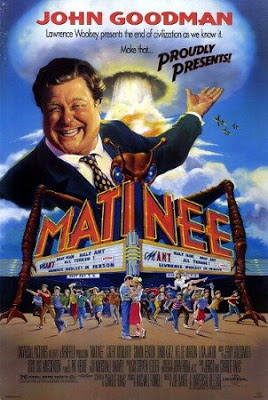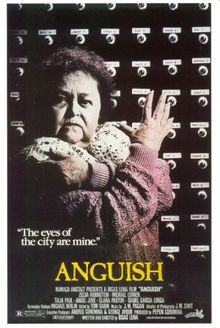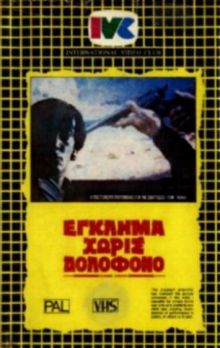Make no mistake: moviegoing can be scary business. I learned this back in 1994 when I witnessed a woman shot in a movie theater, as well as my early 1990’s tenure as a movie theater employee, during which time I was yelled at, threatened, groped, pelted with candy and (if you count the time I was jumped by three skuzzy assholes while on my way to work) assaulted. Then there were the events of July 2012, when a maniac killed twelve people in a Colorado movie theater, an act that obviously dwarfs all the above occurrences, and proves that movie theaters aren’t always the benign venues they’re made out to be.
Horror cinema has of course already pointed this out, even if such movies tend to be fairly rare. Indeed, if there’s anything about the following list that surprises me it’s that I’ve only been able to uncover six worthwhile movie theater set horror films. Certainly there exist quite a few horror movies containing memorable sequences that occur in movie theaters—think of the wonderfully surreal movie house-filling-up-with-zombies scene in MESSIAH OF EVIL, the blob oozing out of the projection booth in the original BLOB, or the outrageous “film break” in GREMLINS 2—but what I’m after here are films in which movie theaters play an integral role. Such films do exist, and the five listed below memorably span the horror spectrum, with a comedy-heavy offering, a postmodern art film, a whodunit and an unapologetic splatter fest.
Counting down, let’s start with…
 6. MATINEE
6. MATINEE
This was Joe Dante’s affectionate 1993 tribute to the legendary gimmick-meister William Castle. MATINEE pivots on a very Castle-esque movie mogul played to sleazy perfection by John Goodman, who’s promoting his latest opus MANT! (“Half Man! Half Ant! All Terror!”) in a Key West movie theater during the Cuban Missile Crisis of 1962. Much of the film takes place during a Saturday Night screening of MANT!, in the course of which all sorts of shenanigans occur. The hilariously endearing black-and-white MANT! perfectly captures the type of trashy moviemaking practiced by William Castle, and is, frankly, the sole reason to watch MATINEE, which is otherwise little more than an extended episode of THE WONDER YEARS.
5. THE BLIND OWL (LA CHOUETTE AVEUGLE)
In 1987 Chile’s late Raul Ruiz made an interesting art film called LIFE IS A DREAM, a surreal reverie set largely in a movie theater. Ruiz’s BLIND OWL, made the same year, is similar, being a movie theater set adaptation of Sadegh Hedayat’s classic of horrific schizophrenia. The film centers on a movie theater projectionist who becomes transfixed by a dancing woman he sees on the screen. That’s just the start of an insanely wide-ranging narrative that sees Ruiz gleefully pile on all manner of complications until it’s impossible to discern what is supposed to be “real” and what isn’t. Ruiz provides many impressively visualized moments as well as some gruesome ones (severed body parts are a constant), with a style that playfully emulates the melodrama of traditional horror and mystery filmmaking. Not every viewer will find THE BLIND OWL’S relentlessly self-referential nature (in which every scene calls attention in some way to its own artificiality) edifying, but for those willing to stick with it the film is an undeniably fascinating mind-twister.
 4. ANGUISH (Angustia)
4. ANGUISH (Angustia)
Spain’s Bigas Luna made this 1987 English language horror film for the American market. It features a creepy old woman (Zelda Rubinstein) who hypnotizes her grown son (Michael Lerner) into killing several people and stealing their eyeballs. After a half hour or so we learn that the preceding is actually a film-within-a-film called THE MOMMY, playing in a packed movie theater. Among the theater’s patrons are two teenage girls, one of whom (Talia Paul) grows increasingly frightened, especially when a pistol-wielding guy seated nearby becomes a little too inspired by THE MOMMY. Luna was fairly inspired here, pulling off some interesting visuals in the movie theater set scenes (such as a shot of a girl viewing a guy on the screen who’s also watching a movie). Unfortunately those scenes are only a portion of the overall film, too much of which is taken up with the silly and pedestrian THE MOMMY. In a direct reversal of MATINEE, ANGUISH’S biggest problem is the fact that the movie within the movie is complete nonsense, and its presence severely cripples the overall film.
3. DEMONS (Demoni)
A classic of sorts, a rollicking 1985 gore fest that once again presents us with a movie-within-a-movie. But unlike the above-mentioned films, that angle is a muted one that only lasts about half the film, as the patrons of a movie theater showing a lurid slasher flick find the onscreen nastiness spilling out into the real world. The proceedings quickly degenerate into a splatterific joyride, with the movie theater’s patrons turning into flesh eating demons. The surviving humans for their part prove quite resourceful in battling the demons, managing to bring a samurai sword, a motorbike and even a helicopter(!) into the theater. There’s little in the way of a story, and the film overall would have benefited from a more imaginative treatment, but taken as is DEMONS delivers.
2. CLOSED CIRCUIT (Circuito Chiuso)
A word of advice to those wanting to see this 1978 film: try not read too much about it beforehand (including my review). It’s an Italian made giallo that gradually morphs into something far stranger and more horrific. It features a diverse group of people viewing a crappy Spaghetti Western at a big city movie theater; during the film’s climax, depicting a GOOD, THE BAD AND THE UGLY-esque stand-off, a middle aged theater patron inexplicably slumps over with a gunshot wound in his chest. A thorough investigation into the killing is launched but turns up nothing…until CLOSED CIRCUIT’S end, when a wholly unexpected truth is unveiled. CLOSED CIRCUIT is a first-class exercise in misdirection, with helmer Giuliano Montaldo initially making us think we’re viewing a conventional murder mystery; the film, however, is actually a highly eccentric meditation on the destructive power of celluloid. As such CLOSED CIRCUIT’S qualities are undeniable, with a climactic sequence that displays considerable audacity in its depiction of on and off-screen characters interacting.
1. TARGETS
I may be cheating a bit here, as the movie theater of this film is a drive-in theater, something you don’t see too much of these days. Nonetheless, this 1968 Peter Bogdonovich production is the most imaginative, horrific and (drive-in setting aside) up-to-date film of its type. TARGETS features Boris Karloff, essentially playing himself as an aging horror icon on a collision course with a much younger, more modern monster: Tim O’Kelly as a clean cut suburban psychopath who one day embarks on a senseless killing spree. Neither character is aware of the other’s proximity until the very end of the film, but Bogodonovich makes it clear early on that these guys are headed for a collision, as are our conceptions of what is scary now (O’Kelly) and then (Karloff). That collision, appropriately enough, takes place in the aforementioned drive-in, and in a sequence far more impacting today than it was back in 1968, involving as it does a rifle-wielding lunatic shooting at moviegoers. An unforgettable film, and one of the screen’s most intelligent and unflinching dissections of the link between real and reel life violence.
